The Indian sub-continent has one of the richest records in the form of rock paintings. The rock-shelters in India were mainly occupied by the Palaeolithic and Mesolithic people in India. Cave petroglyphs began in Upper Palaeolathic Age. The rock paintings of this period are symbolic representation of the primitive way of life. Sympathetic magic was the underlying motive of the painting. Primitive man might have hoped of improving his chances in hunt by first capturing the animal symbolizing on the walls. Cave shelters have expressed their emotions, experiences and his great leap of progress, his achievements and warfare with his jungle associates. Animal figures dominate in the rock paintings of upper Palaeolithic age. The enormous drawing of buffalo at Azamgarh, the wild buffalo at Tatkali Badami, long horned bull at Kaiwala, rhinoceros of Lakhaguar, tiger of Achemid all belong to this period.
In the earliest paintings sympathetic magic was the underlying theme. The hunters believed that by drawing a scene of hunting on the walls the chances of success in the actual hunt improved very much. In the next stage hunting and dancing scenes, mythical animals also sometimes appear. Human figures often with masks, birds, animals and some geometrical patterns are also observed. Some of the geometric patterns were used to fill empty space in the bodies of the animals. The cave paintings of the Chalcolithic period can be compared with the drawing on the pottery of that period.
Earliest traces of human life in India are found in Bhimbetka rock shelters. Analyses suggest that some of these shelters had been inhabited by humans for more than 100,000 years Paintings are executed mainly in red and white with the occasional use of green and yellow colours. The designs are mostly geometric. Other subjects are the lives of the people who lived in the caves, including scenes of childbirth, communal dancing and drinking, religious rites and burials, as well as indigenous animals
With the discovery of bow and arrow man achieved the feeling of safety. The period gave leisure to ponder on the problems relating to the creation of the universe and life after death. Organization of family and community structure evolved different taboos and magical rituals and other achievements are all reflected through the art activities of this period.
Mesolithic Age 10,000 to 7,000BC
Mesolithic age the complete nomadic trends of the social life marked a change. Basically, the life and climatic conditions were not very different only, life was more vigorous, full of vitality in culture and the spread of human occupation from hill to hill, cave to cave, in thickly wooded forests, open grass land and even sparsely populated dune belts seems to have been frequently.
The first confirmed settlements appeared 9,000 years ago in the Bhimbetka rock shelters in Madhya Pradesh. The shelter was of Mesolithic people and, was in caves, rock shelters and in habitat jungle with rocky out crops of river and coastal plains. The various sites of the Mesolithic period were located in Langhnaj in Gujarat, Bagor in Rajasthan, Sarai Nahar Rai, Chopani Mando, Mahdaha, and Damdama in Uttar Pradesh, Bhimbetka and Adamgarh in Madhya Pradesh, Orissa, Kerala, and Andhra Pradesh. Some of the agricultural practice also evidenced at these sites. About 6,000 B.C., the Mesolithic people may have partly adopted the settled way of life and started domestication of animals including sheep and goat. The people shifted of hunting from large animals to small animals and fishes. Gujerat, southern Rajsthan, many sites in Karnataka, Andra Pradesh, Belan Valley, eastern Vindhyas of MP and UP, Narmada Valley, and Bhimbetka show continued inhabitation since Palaeolithic Age.
The occupation in the period was hunting, fishing, food gathering, herding and initial agriculture as is also evident and beginning of food production at its closure. Crude pottery were discovered in this period. The Mesolithic people may have partly adopted the settled way of life and started domestication of animals including sheep and goat.
The compositional elements of the painting in this period is highly developed. Man hunting and dancing are shown with great vitality, inaction. Mythical animals are also sometimes depicted. Human figures are sometimes portrayed wearing mass. There are also engraving of animals, birds like peacock human figures and geometric patterns.
The sites of Bagor in Rajasthan and Langhnaj in Gujarat elucidate that these Mesolithic communities were in touch with the people of the Harappan and other Chalcolithic cultures and traded various items with each other.
Mesolithic paintings are eclipsed by a remarkable stylistic and thematic change in central India. The Mesolithic people may have partly adopted the settled way of life and started domestication of animals including sheep and goat. Paintings show there was domestication of animals like humped bull, goats and sheep. However, fishing and some agricultural practice is also evidenced at these sites. We find two wheeled bullock carts and many other features of the agricultural based settle lifestyle. Other subjects painted on walls are the life of people who lived in caves, including scenes of childbirth, communal dancing and drinking, religious rites and burials, as well as local animals.

Mesolithic prock paintings, Nurla Ladakh

Group activities
The paintings of the hunter gatherers do not show any technical advancement/evolution. The depiction of animals was quite naturalistic The paintings give a remarkable detail of the various activities for example hunting groups, hunters driving the animals between two rows.
Animals
The most interesting one that is used for the deified animals is the pattern of honeycomb design and its variants. Sometimes geometric patterns are also added to fill the body. Spirals and zigzag patterns are often used to fill rectangular masses. Deified animals were drawn in extremely big sizes and filled with the patterns referred above. Some times composite animals were depicted. Bull. Boar, elephant combined in one were shown.. Mythical animals are also sometimes depicted. Such figures were popular in Harappan and Historic periods as well. The stories or incidents of tribal strife’s have been symbolically painted.



| Gufa Matir | Kathotya | Urden |



| Urden | Dharampur | Lakhajwar |

Bhimbedka
Human figures
Human beings are reduced to stick a form in a most sophisticated manner to express movements like running, jumping, and dancing. Intricate designs, plant and animal makeup landscape, a landscape of water, and water plants with fish in between and ducklings and birds in flight denoting the air. All the innovation of the time, like bow and arrow, spears and microlithic tipping’s are shown from the beginning. Hunting was the task of the male members of the society family.



| Hathital | Panchmarhi | Panchmarhi |



| IIE-19 | Jaora | Gufa Mandir Bhopal |
Activities
Man are seen with basket on his back grabbing a piglet by its hind legs, climbing trees, stumbling during the dance, hanging a small bag on a projected branch, placing a hand net on the ground to have both hands free to grab turtle, stringing cough fish onto a rod, nursing babies, grinding fruits and seeds, employing baskets, eating from a laid table inside a house. It tells the hunting incidents, of charging rhino, of birds which rest on grazing buffalo horn, and many other details. Man is seen with basket on his back grabbing a piglet by its hind legs, climbing trees, stumbling during the dance, hanging a small bag on a projected branch, placing a hand net on the ground to have both hands free to grab turtle, stringing cough fish onto a rod, nursing babies, grinding fruits and seeds, employing baskets, eating from a laid table inside a house. It tells the hunting incidents, of charging rhino, of birds which rest on grazing buffalo horn, and many other details. Honey gathering is also shown quite vividly in Punchmarbhi paintings. Honey was the essential source of energy. Drinking of wine was not known.
Groups of the Mesolithic people moved from one place to another are also found in paintings. People carrying baskets over the head or on the back have been shown. Women carrying baskets on their backs indicate them as load bearer.
Activities



| Bhimbedka | Putli | Rajat Prabhat shelter |


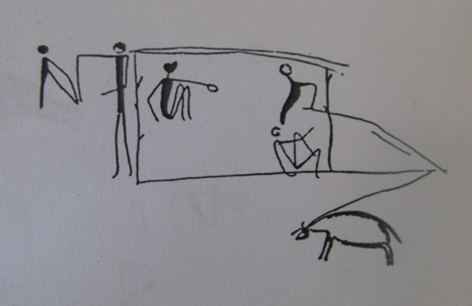
| Dhuna PanchmarhiPutli | Cheel Dant | Kathotya |

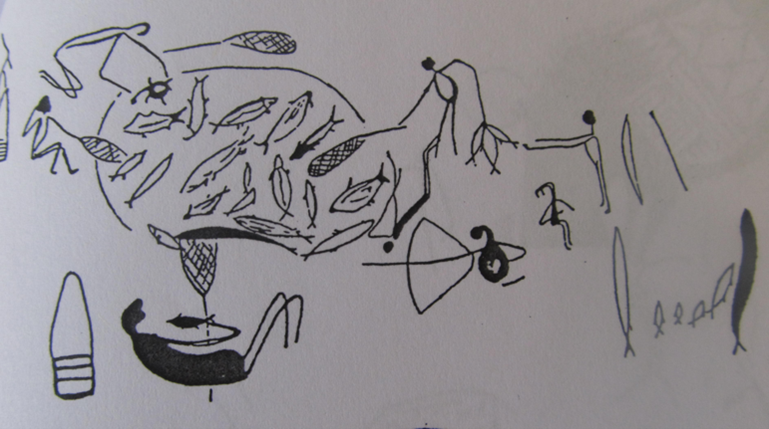
| Lakhajoar | Panch marhiHoshangabad |

Bhimbedka

Bhimbedka
Ritual dances
- Among rituals, dancing around the fire, dancing in line are often depicted. Stepping towards forward and backward, clapping to the rhythm of steps, clapping over the head, and under the raised knees, dancing to the rhythm of clapping by a leader in the center, individuals dancing in highly sophisticated masks and dress, dancing with alternate male and female partners, dancers with horn headdresses, and with camouflaged faces and bodies, dancing with stick in hands and to the tunes of horn pipes and stone drum beating was extremely popular. Whether the dancing was to avert evil spirits or to please a divinity or with magico-religious aspect is not known but they are predominant in rock paintings. They may have the same purpose. Whether the dancing was to evert evil spirits or to please the divinity or magico-religious aspect is not known.
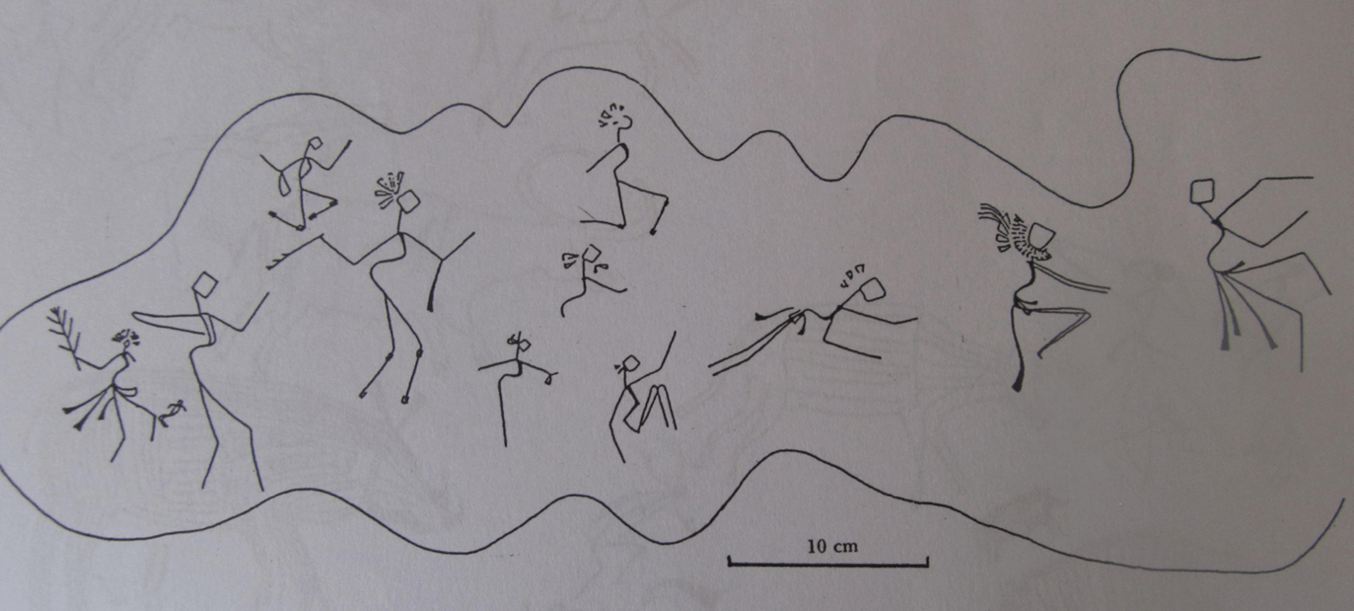
Kharwai


| Bhimbedka | Bhimbedka |

| Bhimbedka |
Taming animals ?



| white demon Dorothy Deep selter , Pachmarhi Hills | Jambu deep Shelters, Panch marhi Hills | Kathoya? |
Female figures and Mother cult
This often developed into a sort of Mother Cult. Female figures of highly styled form, most probably indicate the Mother cult objects. Male female union is sometimes shown. Women are depicted as pregnant women with childbirth, mother and child occasionally drawn. Women as a load bearer are also shown. Most often they carry baskets over their back, either conical or flat bottomed in form. Nourishment was left to female members.
This often developed into a sort of Mother Cult. The bone figure of Mother Goddess from Belan Valley, the sucking Mother Goddess of Jaora Malkhar, the child birth from the Mother’s artmpit from Bhanpura, re concrete evidence of it. Females figures of highly stylized form most probably indicate the mother cult objects.



| Panch marhi | Maro dev shelter | Lakhajoar |

Bhimbedka
Curing paintings
Curing by magic must have often used to lay an important role. Pendant made of wild boar, tusks, ostrich egg shell beads, and wooden beads were often used to ward off ailments. Curing by magic sweeping the body with brooms or casting spells on the sick to cure them were shown. Pandents made of wild boar tusks, ostrich egg shell beads and wooden beads were often used to ward off ailments.
Ritual dance and Masked figures
Human figures are sometimes portrayed wearing mask. Ritual dancing around fire, shown stepping forward and backward, clapping to the rhythm of steps, over the head and under raised knee, escorted by a leader in the center. Individual dancing in highly sophisticated masks, alternating with male and female partners, dancers with horned heads, with camouflaged faces and body, sticks in hands and to tune horn pipes and stone drum beating was popular scene.
While hunting shaman or ogha served as a guide. He would have elaborate headdress often use of square or triangle shield. Bamboo and rope traps in U shaped , triangular or semi circle were formed. Obstacles were created planting sharp bamboo pieces to trap the animals. Lance points with several barbs of stone triangles, bone pointed arrows, bone harpoons, stone tipped lances and arrows were used as hunting weapons. Bow and arrow was a great achievement for hunting. It is also used for rituals. In this case they are often decorated.
Sophisticated masks either in form of decorative ornaments or for magico-religious taboos. Animals such as bos, deer, rhino, monkeys were modelled for the head dresses or their skull were used for this purpose. Feathers of different birds were also used.

Deified Animals Mesolithic Age
Deified animals is in big size and filled with painted in a pattern of honey comb designs and its variations. Sometimes geometric comb design. Sometimes composite animals were depicted. Boar, bull and elephants combined in one. Such figures are popular in Harappan and historic periods too.
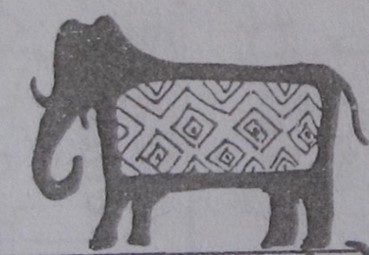
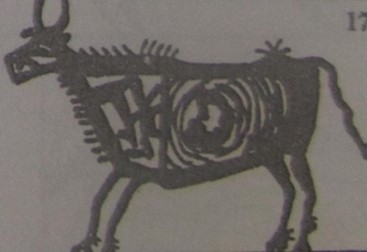

Cultic art.
Mesolithic art was a cultic art. It reflected the needs of an egalitarian group to magically influence an environment that could not be rationally controlled. Primitive man did have awareness of a vast and hostile word, struggling in a corner, overawed by enormous animals and the terrible events. He formed himself into a group and painted for sympathetic magic, ceremonial cure, for banishing fear, exorcising evil or for curing any illness. Men, holding a stick, sharing a communal hunt, led by a chieftain, exhorted by a wizard are also seen. Rhythmic, repetitive, monotonous drum beats, dancing steps and the musical tunes fell logically in step in the communal hunt. Even the decorative motif like helmets and hanging tassels and skirts for hunters had a curative effect.
Neolithic and Chalcolithic rock paintings
The Neolithic Age is mainly characterized by the development of settled agriculture. Considerable progress was made in Neolithic Age in terms of technology. The people developed the practices of cultivation and the major crops were grown. The people of this age started domestication of animals, like cattle, sheep, and goats, building houses, pottery, weaving, and writing. This revolutionized man’s life and paved the way for the beginning of civilization. Their thought involved with household and fertility rituals. Art and crafts developed in this period.
- Agricultural communities had spread in all direction s from Vedic Saraswati and encounters with the tribes and the charioteers were often painted in the shelters Soon the assimilation process started and led to the coexistence of both communities Horse and Neelgai are the two animals introduced to Malwa, rathas- chariots drawn by neelgai , deer, horses, and bullhave been depicted in Shahad-karad, Dharmpuri, Jaora Malkhar, Chiklod and Mirzapur areas.

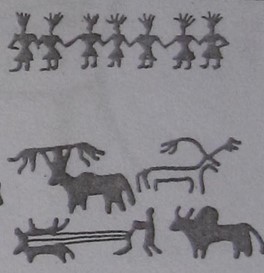
| Chariots in rock paintingsab-Asan,cdi- Katiyakund, e- Chatur, f-Chibarnalag- KanyaDeh, j- Adhar | Chalcolithic motifs |
Masked men


| Neolithic | Neolithic |
Alpana
The designs are mostly geometric. They are symbolic representation of the primitive way of life.

| Chalcolithic Motifs |

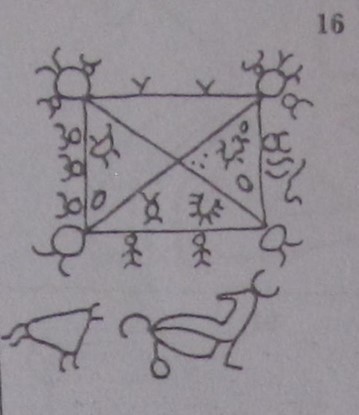

| Pengawana. | Kharwai | Bhimbedka |
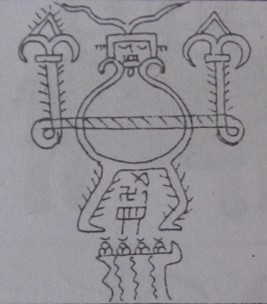
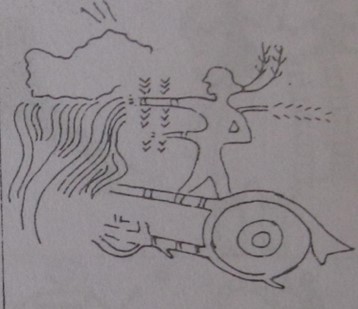


| yaksha Binayaka | Rain god, Monterosa | Ajamgarh | Panchmarhi |
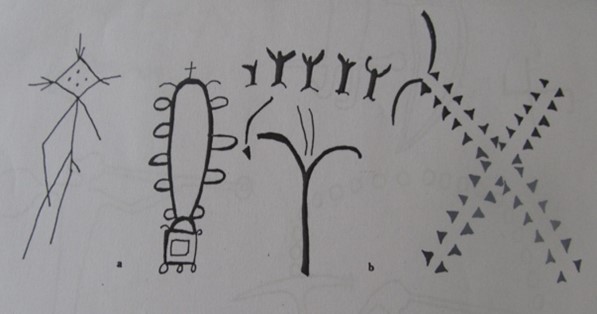
| Maro dev shelter |

